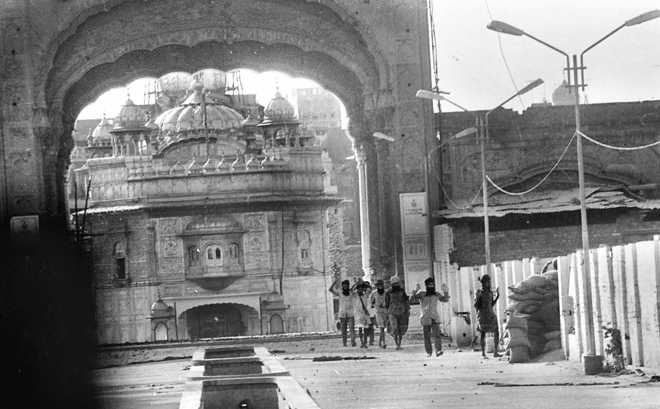SHORTLY before 1 pm exactly 28 years ago, a militant armed with an AK-47 assault rifle inside the Golden Temple complex opened fire on Sarabdeep Singh Virk, then a DIG with the CRPF posted in Amritsar, injuring him in the jaw. Virk, who later became Punjab's DGP, was supervising the demolition of a wall being built by terrorists outside the temple premises. The single shot, which wounded Virk, quickly escalated into an intense exchange of fire between the CRPF stationed on about a dozen pickets overlooking the temple complex and the 150 odd militants then residing inside.
The chance incident marked the beginning of the relatively forgotten Operation Black Thunder-II conducted with much precision, coordination and transparency without evoking any public protest and controversy. It culminated in the abject broad daylight surrender by terrorists in the media's presence 10 days later, on May 18, 1988, without the security forces entering the temple complex.
This was in stark contrast to the messy June 1984 Operation Blue Star conducted four years earlier, when the Army stormed the temple complex much to the angst of the Sikh community worldwide. Then resentment led to the creation and subsequent proliferation of terror groups in the state that engaged in wanton violence. By May 1988, about 30 such groups and factions were active, with some of them brazenly occupying all rooms along the temple’s parikarma that rings the Harmandar Sahib, the sanctum sanctorum. One of the two panthic committees, an apex body of a group of terror organisations, had opened an “office of Khalistan” in room 14, where they regularly held news conferences. On several occasions, the terrorists registered their presence by firing in the air while the security forces silently watched a re-run of similar activities that had occurred in the temple complex prior to Operation Blue Star.
Barely two months earlier, according to M.K. Dhar, former Joint Director Intelligence Bureau in his book Open Secrets, the IB had quietly begun supplying AK-47s to the then Akal Takht Jathedar Jasbir Singh Rode, who incidentally is Jarnail Singh Bhindranwale's nephew. Rode, an IB operative who was anointed jathedar of the supSikh temporal seat, was tasked to create a Trojan Horse comprising a 15-member squad to neutralise the terrorist gangs inside the temple. In all, three consignments of AK-47s were supplied to him prior to Operation Black Thunder-II. This measure, however, yielded only a “limited result,” with a total three terrorists belonging to the “Khalistan Commando Force” being killed.
But with Virk being shot, the IB's operations took a back seat. On May 11, specially flown in National Security Guard (NSG) commandos took control of the CRPF pickets overlooking the complex and established a tight cordon around it. While the commandos prepared to enter the temple complex for a third time in four years (the second time was Operation Black Thunder-I on April 30, 1986, when the NSG entered following the declaration of “Khalistan” a day earlier from inside), NSG sharp shooters armed with sniper rifles equipped with night vision shot at everything that moved thus keeping all inside the temple complex pinned down. A few terrorists were shot dead in the process. In the following days, NSG commandos quickly established control over all buildings in the outer areas of the temple complex, starting with the 300-feet-high water tank, the SGPC office, Teja Singh Samundri Hall and the various niwas’. They systematically reduced the area of operation to the inner section of the temple complex after taking control of the Manji Sahib, Diwan Hall, the langar building and by neutralising terrorists occupying the two towering 18th-century Ramgharia bungas which presented a commanding view of the NSG positions and the temple complex. Interestingly, as the operation progressed, curfew was confined to just 300 yards around the temple complex during day and the Walled City at night, while life elsewhere functioned normally.
At a policy level, it was decided to wear down the terrorists. Continuous sniping and heavy machine gun fire brought on the bungas day and night kept the terrorists pinned, while bringing on them psychological pressure. The sound of gun fire was punctuated by periodic declarations of unilateral ceasefire accompanied by calls for surrender which resulted in flushing out of many of the terrorists, along with all the devotees caught inside. On May 18, a final batch of 46 terrorists, who had taken refuge inside the Harmandar Sahib three days earlier, walked out with their hands in the air, marking the end of the 10-day- long siege. Three NSG commandos were injured while conducting a flushing out operation in the langar and Manji Sahib buildings. It is a different story that all the terrorists were subsequently exonerated for “lack of evidence” and that the Punjab Police had to resort to “other means” to keep them in jail.
In the following days, over 40 bodies, some by then skeletons, were exhumed from the debris of the Akal Takht lying in the outer temple complex further exposing the terrorists for what they were — armed criminals and extortionists who had been misusing the temple premises to torture and kill people they suspected to be police informants or had been summoned for dispute settlement.
This was one occasion when the government got an anti-terrorist operation right. Maintaining considerable transparency facilitated the security forces, especially after the terrorists entered the sanctum sanctorum — much to the consternation of the security forces which feared that the armed militants could either blow up the Harmandar Sahib or commit mass suicide. Among the several tactical and policy-level lessons from this near-forgotten chapter of India's anti-terrorist operations is the need for preventing such situations from arising in the first place rather than allowing them to grow.
dkumar@tribunemail.com
Unlock Exclusive Insights with The Tribune Premium
Take your experience further with Premium access.
Thought-provoking Opinions, Expert Analysis, In-depth Insights and other Member Only Benefits
Already a Member? Sign In Now











